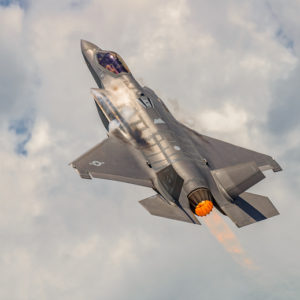The federal government has been throwing money at solutions to the coronavirus economic displacement that is crushing the U.S. — and world — economies.
This is a time when the federal government needs to find ways to save taxpayer money and to spend wisely. The federal government needs to cut bloated contracts to save money for the efforts to respond to the devastating effect of the coronavirus on economic activity.
One easy target is the massively expensive F-35 Joint Strike Fighter program.
Government contracts that are way over budget and slow to deliver need to be dialed back immediately so the federal government has more money to respond to the unemployment and potential shuttered businesses resulting from the coronavirus crisis.
Congress passed one of the most expensive pieces of legislation in American history with the $2 trillion Coronavirus Aid, Relief, and Economic Security ACT (CARES) to provide some social insurance and a safety net for individuals and businesses facing hardship.
In contrast, the F-35 is a program to produce an Air Force fighter jet that is expected to cost more than $1 trillion over the life of the program. For the fighter jet, there are less expensive alternatives that are just as lethal as the F-35.
It is time to make some choices and to cut down bloated government contracts to preserve funding to continue the fight against the economic consequences of the virus.
The fact is that the CARES Act legislation is necessary and has overwhelming support. Republicans in Congress are floating a $250 billion provision to further aid small businesses while President Trump and Speaker of the House Nancy Pelosi have floated a $2 trillion infrastructure idea. This is all adding up and creating a situation where the federal government is going to run out of resources to pay for everything.
Our national debt is a staggering $24 trillion. Spending this year is expected to exceed $2 trillion and spending will be at a record high.
John Mauldin of Forbes wrote on April 2, “Between reduced tax revenues and increased spending, I now expect this year’s deficit will be at least $4 trillion.”
His projections factor in about an additional $1 trillion in new spending this fiscal year. These numbers are shocking and make one wonder — how are we going to pay for all this new spending?
While this is going on, other programs seem to be on autopilot. Popular Mechanics reported on April 2, “The U.S. Military just placed an order for 78 new F-35 Joint Strike Fighters, a $4.7 billion agreement that will provide planes for the U.S. Air Force, Navy and Marine Corps.
The announcement comes as the Marines signal they don’t have enough pilots to fly its planes and could eventually cut the number of aircraft the service orders.”
The military does not have enough pilots to fly the planes, yet they are spending billions anyways. That does not seem like an appropriate way to spend federal money in this time of crisis.
The F-35 program has proven to be the most expensive program in the history of this nation and cost about $320 billion in 2012.
In another Popular Mechanics report from 2019, they found that “private analysts have called the F-35 a ‘money pit,’ and argued that the purpose of Lockheed’s extensive national and global supplier base — which includes 1,300 suppliers in 45 states and nine foreign countries — was not so much to realize logistics efficiency and security, but to make sure the Joint Strike Fighter was too big to fail.”
The aircraft took over 18 years from the start to actually being used and has been plagued by delays and manufacturing issues since day 1. Lockheed has been successful in setting up a program that has failed over the years to deliver yet continues to receive massive funding.
The Congress and Trump administration need to completely overhaul the way they spend taxpayer and borrowed cash to make sure our government does not become insolvent.
A good starting point would be to audit the F-35 program and cut as much of the waste they can to find less expensive alternatives.

